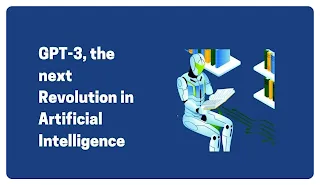Generative Pre-Trained Transformer 3 (GPT-3): Breakthrough in Artificial Intelligence
Generative Pre-trained Transformer (GPT) are a series of deep learning based language models built by the OpenAI team. These models are known for producing human-like text in numerous situations. However, they have limitations, such as a lack of logical understanding, which limits their commercial functionality.
In this article, we describe the latest GPT model GPT-3’s functioning mechanism, importance, use cases, and challenges in order to inform managers about this valuable technology.
What is the GPT-3?
GPT-1, GPT-2, and GPT-3 were developed by OpenAI researchers to produce more intricate models that produced speech that was more human-like. On an expanding text corpus, they developed these increasingly complex models.
The number of parameters grew quickly over time as more models like the GPT-1, GPT-2, and others were used in the field (Figure 1). In contrast to its rivals, the GPT-3 model's complexity surpassed 175 billion parameters by 2020.
How does GPT work?
GPT-3 is a pre-trained NLP system that was fed with a 500 billion token training dataset including Wikipedia and Common Crawl, which crawls most internet pages.
It is claimed that GPT-3 does not require domain specific training thanks to the comprehensiveness of its training dataset.
Why is it relevant?
Tasks that require advanced technical knowledge and linguistic comprehension could be automated using GPT-3.
Examples demonstrate its ability to decipher complex documents, initiate actions, send out alerts, or produce code. Application fields include technology, client services (e. g. helping customers with their inquiries), marketing (e. g. or sales (e.g., by creating eye-catching copy). g. communicating with prospective customers).
What use cases does it have?
The production process rarely employs GPT-3. Below are some examples of how it has been used.
1. Coding
The ability of GPT-3 to translate instructions from human language into code has been demonstrated in a number of online demos. Please be aware, though, that none of these are reliable, production-ready systems. They are predicated on online examples of GPT-3's potential:.
Python.
Basic Python tasks have been programmed by GPT-3.
SQL.
Without using human operators, GPT-3 is able to automatically create SQL statements from straightforward text descriptions.
2. Machine Learning/Deep Learning Frameworks
Code for deep learning and machine learning frameworks like
Keras has been created using GPT-3.
3. DevOps solutions
On the cloud, DevOps services have been listed, deleted, and
created using it. The management of these services could be automated if it
operated in a stable, predictable manner.
4. Front end design
Using CSS or JSX, it can produce website layouts that meet user requirements.
5. Chatbots.
Human-like conversations can be carried out by GPT-3. It has
the potential to advance today's chatbots, even though it still needs to make
significant advancements in the areas covered in the "What are its
limitations?" section.
Without the need for case-specific pre-training, it is able
to translate, respond to intangible queries, and serve as a search engine with
precise responses and source links.
6. Auto-Completion
GPT-3 was designed for auto completion and is the most human-like system for that, according to the IDEO team, who used it as a brainstorming partner.
ChatGPT is the most recent GPT-3 update.
ChatGPT: What is it?
The GPT-3 language model has a variant called ChatGPT that was created specifically for dialog generation. Although its language model is sometimes referred to as GPT-3.5, it is actually an improved version of GPT-3 and not a completely new model.
ChatGPT has dominated the search results since its launch on November 30, 2022. The 1 million user cap was reached in just 5 days (see the graph below). Along with its notoriety, it also attracted a lot of skepticism from a variety of professionals, including teachers and programmers. Teachers worry that their students will use the chatbot to write excellent papers, for instance, and programmers worry that the chatbot will take their jobs away because of how well it codes.
Distinctions from GPT-3.
The fact that ChatGPT was trained using a sizable dataset of conversational data distinguishes it from GPT-3 and is one of its main differences. It can now produce text that is better suited for chatbot conversations because it has become familiar with the idioms and patterns of human speech. The GPT-3 language model, in contrast, is general-purpose and has not been trained specifically for dialogue generation.
The two models' sizes also differ from one another. ChatGPT has fewer parameters than GPT-3 and is a smaller model. Because chatbots must react immediately to user input, this makes the application faster and more effective to use.
In general, ChatGPT is a tailored variant of GPT-3 that is especially made for producing natural language text for chatbot conversations. It is a more compact and effective model than GPT-3 and was trained on conversational data.
Training Approach.
Utilizing Reinforcement Learning from Human Feedback (RLHF), the language model was improved. 2 The method uses human AI trainers to simulate conversations while providing them with access to output suggestions produced by the model itself to aid in creating their responses.
Second, a method for developing a reinforcement learning reward model (RM) was applied. The method entails gathering comparison data from conversations between AI trainers and the chatbot and using this data to rank the caliber of various model responses. The model is then adjusted using Proximal Policy Optimization (PPO), which makes use of this data. After that, the procedure is repeated several times to enhance the model.


.webp)
.webp)
.webp)

.jpg)